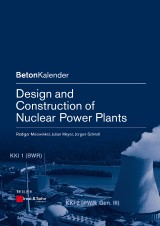Details

Design and Construction of Nuclear Power Plants
Beton-Kalender Series 1. Aufl.
|
52,99 € |
|
| Verlag: | Ernst & Sohn |
| Format: | |
| Veröffentl.: | 05.04.2013 |
| ISBN/EAN: | 9783433602744 |
| Sprache: | englisch |
| Anzahl Seiten: | 150 |
DRM-geschütztes eBook, Sie benötigen z.B. Adobe Digital Editions und eine Adobe ID zum Lesen.
Beschreibungen
Despite all the efforts being put into expanding renewable energy sources, large-scale power stations will be essential as part of a reliable energy supply strategy for a longer period. Given that they are low on CO2 emissions, many countries are moving into or expanding nuclear energy to cover their baseload supply.<br> Building structures required for nuclear plants whose protective function means they are classified as safety-related, have to meet particular construction requirements more stringent than those involved in conventional construction. This book gives a comprehensive overview from approval aspects given by nuclear and construction law, with special attention to the interface between plant and construction engineering, to a building structure classification. All life cycle phases are considered, with the primary focus on execution. Accidental actions on structures, the safety concept and design and fastening systems are exposed to a particular treatment.<br> <br> Selected chapters from the German concrete yearbook are now being published in the new English "Beton-Kalender Series" for the benefit of an international audience.<br> Since it was founded in 1906, the Ernst & Sohn "Beton-Kalender" has been supporting developments in reinforced and prestressed concrete. The aim was to publish a yearbook to reflect progress in "ferro-concrete" structures until - as the book's first editor, Fritz von Emperger (1862-1942), expressed it - the "tempestuous development" in this form of construction came to an end. However, the "Beton-Kalender" quickly became the chosen work of reference for civil and structural engineers, and apart from the years 1945-1950 has been published annually ever since.
Editorial<br> Preface<br> Introduction<br> - The demand for energy<br> - Electricity generation<br> - Importance of nuclear energy<br> Nuclear energy<br> - Generating electricity by nuclear power plants<br> - Nuclear fission<br> - Radioactivity<br> - Reactor designs<br> - Safety philosophy<br> Approval aspects<br> - Atomic energy and construction law<br> - Interface between plant and structural engineering<br> - Periodical safety reviews<br> - Planning and design requirements<br> Building structures for nuclear plants<br> - General notes<br> - Nuclear power plants<br> - Disposal structures<br> - Building execution<br> - Dismantling<br> Extraordinary actions involved when designing nuclear installations<br> - Overview<br> - Internal factors<br> - External actions<br> Safety concept and design<br> - Underlying standards<br> - Partial safety concept<br> - Design instructions for concrete, reinforced and pre-stressed concrete structures<br> - Design instructions for steel components<br> - Particularities of containment design<br> Fastening systems<br> - Fastening types<br> - Fastening with headed studs<br> - Fastening with metallic dowels<br> - Corrosion protection<br> - Fire resistance<br> Waterproofing of structures<br> - Purposes of waterproofing structures<br> - Requirements on waterproofing structures<br> - Black tank<br> - White tank<br> Ageing and life cycle management<br> - Overview<br> - Ageing management of buildings<br> - Ageing mechanisms in building materials<br> - Implementation and documentation<br> References
The authors are extensively involved in planning, operating and inspecting, designing new buildings, retrofits and conversions and updating specific nuclear power rules.<br> <br> Dr.-Ing. habil. Rudiger Meiswinkel has been responsible for construction engineering at E.ON Kernkraft GmbH, Hanover/ Germany from 2001 to 2012 and operates since 2012 the MBI Bautechnik GmbH, Enkenbach-Alsenborn/ Germany. He is a member of Kerntechnische Gesellschaft e. V. (Nuclear Association) and of Deutsche Gesellschaft fur Erdbebeningenieurwesen und Baudynamik e. V. DGEB (German Association of Earthquake Engineering and Structural Dynamics).<br> <br> Dr.-Ing. Julian Meyer is head of HOCHTIEF Consult IKS Energy, Frankfurt/ Germany. He is a member of technical standard committees and project groups, inter alia with regard to design and construction of nuclear power plants.<br> <br> Prof. Dr.-Ing. Jurgen Schnell is director of the Institute of concrete structures and structural engineering at Technical University Kaiserslautern/ Germany. He is a member of numerous German and European technical standard committees and committees of independent experts. Since 2012 he is head of the German Committee for Structural Concrete (DAfStb).
Despite all the efforts being put into expanding renewable energy sources, large-scale power stations will be essential as part of a reliable energy supply strategy for a longer period. Given that they are low on CO<sub>2</sub> emissions, many countries are moving into or expanding nuclear energy to cover their baseload supply.<br /> <br /> Building structures required for nuclear plants whose protective function means they are classified as safety-related, have to meet particular construction requirements more stringent than those involved in conventional construction. This book gives a comprehensive overview from approval aspects given by nuclear and construction law, with special attention to the interface between plant and construction engineering, to a building structure classification. All life cycles phases are considered, with the primary focus on execution. Accidental actions on structures, the safety concept and design and fastening systems are exposed to a particular treatment.<br /> <br /> Selected chapters from the German concrete yearbook are now being published in the new English “Beton-Kalender Series” for the benefit of an international audience.<br /> <br /> Since it was founded in 1906, the Ernst & Sohn “Beton-Kalender” has been supporting developments in reinforced and prestressed concrete. The aim was to publish a yearbook to reflect progress in “ferro-concrete” structures until – as the book’s first editor, Fritz von Emperger (1862-1942), expressed it – the “tempestuous development” in this form of construction came to an end. However, the “Beton-Kalender” quickly became the chosen work of reference for civil and structural engineers, and apart from the years 1945-1950 has been published annually ever since.
Diese Produkte könnten Sie auch interessieren:

Water Quality Hazards and Dispersion of Pollutants

von: Wlodzimierz Czernuszenko, Pawel Rowinski

149,79 €















